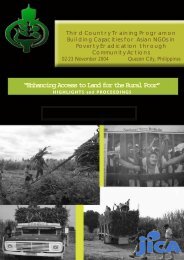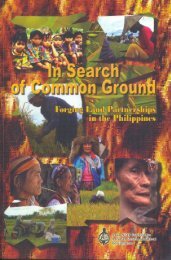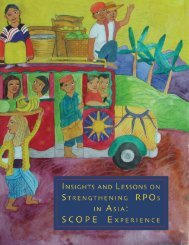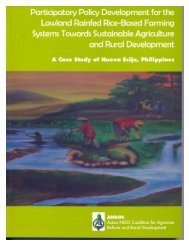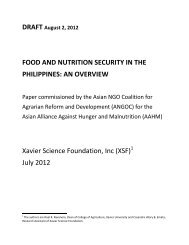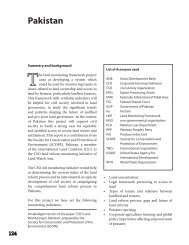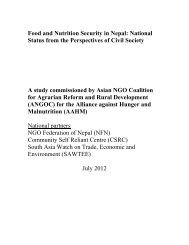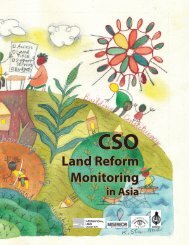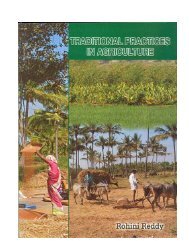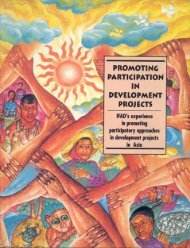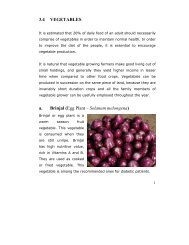Securing the Right to Land FULL - ANGOC
Securing the Right to Land FULL - ANGOC
Securing the Right to Land FULL - ANGOC
You also want an ePaper? Increase the reach of your titles
YUMPU automatically turns print PDFs into web optimized ePapers that Google loves.
SECURING THE RIGHT TO LAND<br />
Endnotes<br />
90<br />
1<br />
Under this system, land could be acquired mostly free of charge from<br />
<strong>the</strong> British colonial government. The landowner or Zamindar, did not<br />
cultivate <strong>the</strong> land himself but rented it out <strong>to</strong> cultiva<strong>to</strong>rs.<br />
2<br />
There was no intermediary between <strong>the</strong> State and <strong>the</strong> cultiva<strong>to</strong>r under<br />
this system. The cultiva<strong>to</strong>r, or ryot, had <strong>the</strong> right <strong>to</strong> sell, transfer, or<br />
lease his land and his tenure remained secure as long as he paid <strong>the</strong><br />
land revenue.<br />
3<br />
Bhoodan (<strong>Land</strong> Gift) movement received millions of hectares of land.<br />
State governments enacted Bhoodan Yagna Acts <strong>to</strong> legalize and facilitate<br />
gift and redistribution of Bhoodan land <strong>to</strong> <strong>the</strong> landless.<br />
4<br />
Diwakar, D.M. “Dalit questions of inequality, exploitation and mobilization<br />
(Articles)”, Journal of Indian school of political economy, Vol. 10<br />
no.2, April-June 1998<br />
5<br />
The Naxalite movement takes its name from a peasant uprising which<br />
<strong>to</strong>ok place in May 1967 at Naxalbari—a place on <strong>the</strong> nor<strong>the</strong>astern tip<br />
of India situated in <strong>the</strong> state of West Bengal.<br />
6<br />
Bidwai, P., “Meeting <strong>the</strong> Naxal challenge, Rediff News, Oc<strong>to</strong>ber 11,<br />
2005, http://www.rediff.com/news/2005/oct/11bidwai.htm<br />
7<br />
Devinder S. and Goswami, B. “India’s new maharajas,” InfoChange News<br />
& Features, CCDS, Pune, December 2006, http://www.Infochangeindia.org/<br />
analysis193<br />
8<br />
Excerpts taken from http://www.bjp.org<br />
9<br />
Excerpts taken from http://www.congress.org.in<br />
10<br />
Excerpts taken from http://www.cpim.org<br />
References<br />
Agenda for Governance of <strong>the</strong> National Democratic Alliance.<br />
Approach Paper <strong>to</strong> <strong>the</strong> Eleventh Five Year Plan.<br />
Behar, A. (2002) Peoples’ social movements: An alternative perspective on<br />
forest management in India. In Overseas Development Institute, Working<br />
Paper No.177.December 2002. London.<br />
Besley, T., & Burgess, R. (1998). <strong>Land</strong> reforms, poverty reduction and<br />
growth: Evidence from India. In London School of Economics, STICERD<br />
Research Paper No. DEDPS13.<br />
Brown, J. (2002). <strong>Land</strong>ed with unfair deal. In The Telegraph.<br />
Das, S. (2000). A critical evaluation of land reforms in India. In <strong>Land</strong> Reforms<br />
in India (Vol. 5). New Delhi: Sage Publications.<br />
Deshpande, R.S. (2003, March). Current land policy issues in India. In <strong>Land</strong><br />
reforms (Special edition). Rome: Food and Agriculture Organization.<br />
Diwakar, D.M. (1998, April-June). Dalit questions of inequality, exploitation<br />
and mobilization. In Journal of Indian school of political economy, 10 (2).<br />
Agrarian structure and reforms <strong>to</strong>wards sustainable basic needs and hu-<br />
man development in Uttar Pradesh. (2007). In Dalit and Human Development.<br />
Abhijeet Publication.<br />
Gupta, A. (2007). A journey <strong>to</strong>wards people’s verdict. Bhopal: Ekta Parishad.<br />
Harris, J.C. (2004). <strong>Land</strong> first. Bhopal: Ekta Parishad.<br />
Carr-Harris, J. (2005). Struggle-dialogue: Tools for land movements in India.<br />
International Institute for Environment and Development.<br />
Jha, P.K. (2002). A perspective on land and forests in Madhya Pradesh. In<br />
<strong>Land</strong> reforms in India, Vol. 7, Issues of equity in rural Madhya Pradesh.<br />
New Delhi: Sage Publications.<br />
<strong>Land</strong> Acquisition (Amendment) Bill. (2007).<br />
Majumdar, R.C., Chaudhuri, H., & Dutt, K.K. (1946). An advanced his<strong>to</strong>ry of<br />
India (1 st ed.). London: McMillan.<br />
Mander, H. (2002). Tribal land alienation in Madhya Pradesh: The problem<br />
and legislative remedies. In P.K. Jha (Ed.). <strong>Land</strong> reforms in India: Vol. 2.<br />
Issues of Equity in Rural Madhya Pradesh. New Delhi: Sage Publications.<br />
Ministry of Rural Development. (2002). Annual report.<br />
Mearns, R. (1999) Access <strong>to</strong> land in rural India: Policy issues and options.<br />
World Bank Policy Research Working Paper No. 2123. Washing<strong>to</strong>n, DC:<br />
World Bank.<br />
National Centre for Advocacy Studies. (2005, Oc<strong>to</strong>ber-December) Advocacy<br />
update on land rights, 18 (18).<br />
Pai, S. (2007, November 17) Janadesh 2007: The land question. In Economic<br />
and political weekly.<br />
Rao, V.M. (1992, June 27). <strong>Land</strong> reform experiences: Perspective for strategy<br />
and programmes. In Economic and Political Weekly.<br />
Samuel, J., Prakasham, G., & Bedi, P. (Eds.). (2002). <strong>Land</strong> for life. Pune, India:<br />
National Center for Advocacy Studies.<br />
Sarin, M. (2005, May 21). Scheduled tribes bill 2005: A comment. In Economic<br />
and Political weekly.<br />
Sethi, M. (n.d.) <strong>Land</strong> reforms in India: Issue and challenges.<br />
Sharma, D., & Goswami B. (2006, December). India’s new maharajas. In<br />
Infochange India. Retrieved from http://infochangeindia.org/<br />
200612166338/O<strong>the</strong>r/Analysis/India-s-new-maharajas.html.<br />
The National Common Minimum Programme of <strong>the</strong> United Progressive<br />
Alliance.<br />
The National Policy for Farmers. (2007).<br />
The NSSO surveys.<br />
The rehabilitation and resettlement bill. (2007).<br />
The scheduled tribes and o<strong>the</strong>r traditional forest dwellers (Recognition of<br />
forest rights) act. (2006).<br />
The special economic zones act. (2005).<br />
The World Development Report. (2008). World Bank.<br />
Thirumalai, S.T. (n.d.) Post-war agricultural problems and policies in India,<br />
195, 13. Bombay.<br />
O<strong>the</strong>r documents referred <strong>to</strong> in this paper.



